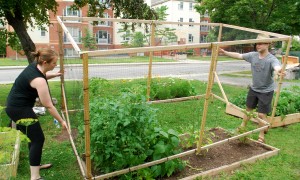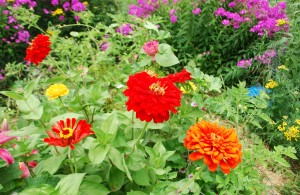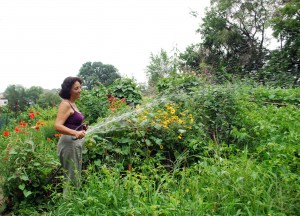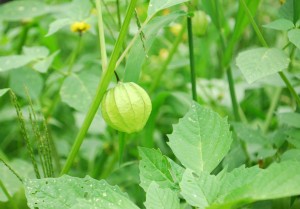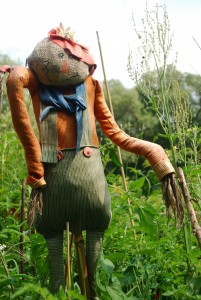The Rapid Growth of Community Gardens in Canada
Vancouver now has over 75 of them; Halifax 25; and Ottawa, at least 40. No matter where you look in Canada, community gardens are becoming one of the country’s quickest growing outdoor activities as more people look for a way to get outdoors, grow their own plants and get back to nature.
A community garden is an urban green space allotted to the growing of plants by the public. All manner of plants can be grown, from herbs and vegetables to fruits and flowers. The green space is divided into plots and each plot is assigned to the public on a first come first serve basis. The spaces themselves are as diverse as the plants grown on them. Some are hundreds of plots large, while others only have allotments numbering in the single digits.
The community gardens are typically run by local groups that may organize a single or group of gardens. Anyone can apply to be a community gardener, but in many cities, plots are being filled faster than new gardens can be created.
Jordan Bouchard is the Interim Coordinator of Just Food’s Ottawa-based community gardening network. He’s seen first-hand the rapid increase of community gardens in the city.
“Community gardening is growing quickly,” Bouchard said. “We’ve more than doubled the amount of urban gardens in Ottawa in the last five years.”
It’s popularity has grown to the point that city websites are warning of wait times to receive a spot.
“Some waitlists are years long,” Bouchard said. “Because of this, many groups are working towards getting more set up in the city.”
There are a multitude of factors behind the recent surge of popularity of community gardening. Some people, like community gardener Brad Mitchell, 47, find tending to a plot of fruit and vegetables a good reason to get outside and into nature.
“I like to get my hands dirty,” Mitchell said. “Some of the gardeners will go and plant fully grown vegetables, but I get a lot of satisfaction out of watching a plant grow from seed and raising it all the way up.”
Mitchell spent five years waiting to get a shot at tending a space at the Laurier and Bronson community garden in Ottawa. While waiting, he volunteered by mowing the grass between plots, helping friends tend to their gardens and by doing general maintenance work around the site.
Mitchell grows beans, tomatoes, lettuce, cucumbers and other vegetables that all appeared to be growing well, but he said there are a few dangers gardeners should be on the lookout for.
“Since the plots are so close together, everything grown is organic. Because of this, we get bugs and pests that will come in and eat the produce,” Mitchell said. He pointed to one of his leafier plants which was dotted with small holes and bite marks.
Another problem gardeners face is thieves who will steal produce. Mitchell said he has lost a fair amount of vegetables to other humans who have picked freshly grown vegetables from his garden.
“I came in one day, and one of my eggplants was just gone. Then I came in the next day, and the second one was gone,” he said. “And not only that, but whoever took it had snipped off the buds, so no more would grow.”
While taking food that a person has not grown is never encouraged, some gardens have begun to implement open pick spaces to combat food theft. The idea being that if someone is going to steal food from a garden, they should do so from a more communal plot that doesn’t belong to any one particular gardening member.
Despite the problems, Mitchell has now been growing for the past five years and said he still enjoys coming out nearly everyday to tend to his plants.
While gardening may be a fun outdoor exercise for many, there are also practical reasons why one might choose to grow in a community space.
Silvia Quintana, 50, works a patch of tomatillos at Ottawa’s Strathcona park. She says that gardening gives her an opportunity to enjoy the outdoors, but also has economic and practical benefits.
“Tomatillos are very common in my home country Mexico, but not so much in Canada,” Quintana said. “Some people here know how to use them, but many people don’t even recognize them.”
Tomatillos (Physalis philadelphica) are used in salsas and dips like guacamole. Common in Mexico, Quintana says she would have to pay upwards of 15 dollars for a bag of them in a Canadian supermarket.
“I come out every couple of days [to tend to the plants], but mostly for pleasure,” Quintana said. “They’re a very hardy plant and can grow well on their own.”
Quintana is able to reap multiple harvests per season from her tomatillos and says she has more than enough left over to give to friends and family.
As the public’s enthusiasm for local urban-agricultural spaces has increased, support and resources from government and non-profit groups has been made available to help those looking to garden in an urban environment.
Vancouver has instituted tax breaks for landowners who develop green spaces on their property. The city now allows developers to classify community gardens as class eight recreational property, reducing the cost owed to the government to about a third of typical commercial property tax fees.
In Ottawa, Just Food, in concert with garden organizers and the city government, works with an $85,000 a year budget to provide tools, equipment and construction and gardening materials to those looking to work in or organize a community garden.
And in Halifax, the Halifax Garden Network organized a creative initiative in 2013 called the Urban Agriculture Tour which brought together a group of growers from the city. The gardeners toured a host of local growing spots and exchanged ideas on what to plant as well as thoughts on gardening techniques.
For those who may be interested in joining a community garden, more information can be found on your city’s community gardening network web-page including contact information of local garden organizers as well as helpful information on how to start working a new plot of land.
Thank you to our guest blogger Dylan Copland for this post and photos. Dylan is a journalist and media specialist living in Ottawa, Ontario. He is currently volunteering with Nature Canada where he is writing about animals, nature and the people who love them. You can reach him at dmcopland@gmail.com and find his portfolio on the web at: dylancopland.wordpress.com.

